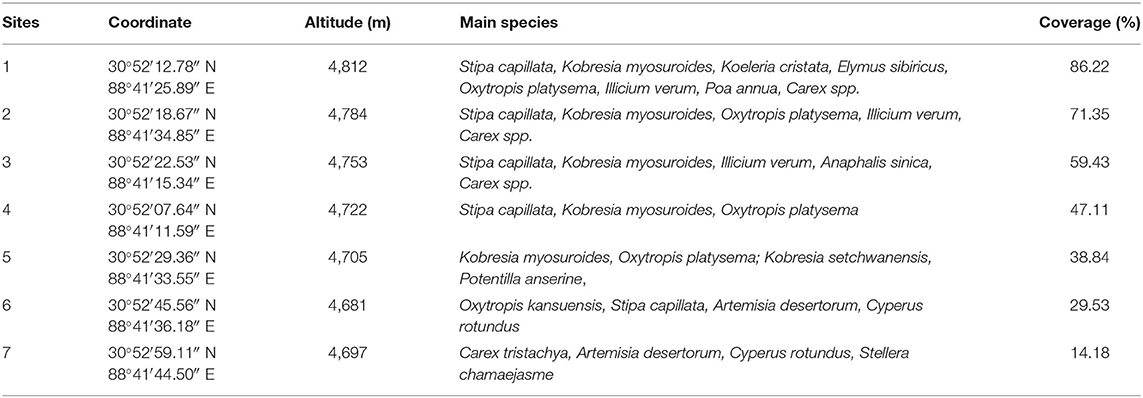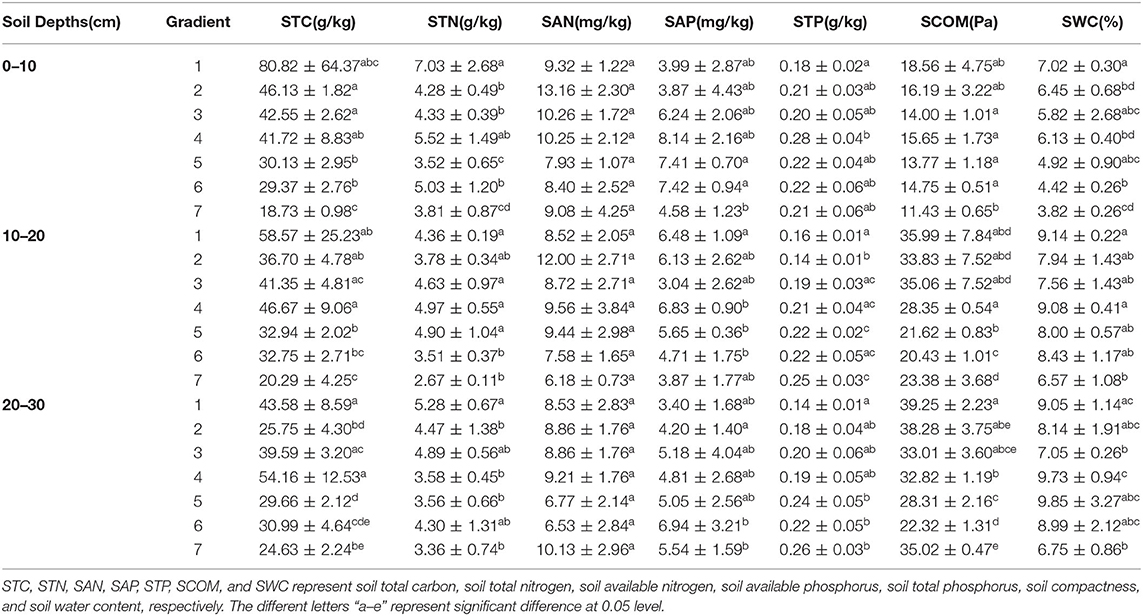- 1Key Laboratory of Ecosystem Network Observation and Modelling, Synthesis Research Centre of Chinese Ecosystem Research Network, Institute of Geographic Sciences and Natural Resources Research, Chinese Academy of Sciences, Beijing, China
- 2School of Soil and Water Conservation, Beijing Forestry University, Beijing, China
Understanding the response of plant community to degradation is fundamentally important for grassland conservation and management. The objective of this study is to examine the changes in soil properties and plant characteristics along a degradation gradient in alpine steppe, and explore the potential mechanisms that biotic and abiotic controls regulate plant community variations. We chose seven sequent degrees of degradation, and conducted a field survey as well as soil and plant samplings in an alpine steppe in Northern Tibet. The results showed that soil water content (SWC), soil compaction (SCOM), soil total carbon (STC), and total nitrogen (STN) dramatically decreased along the degradation gradient. The species richness, overall aboveground biomass (AGB), and AGB of graminoids were apparently reduced with increasing degradation, while AGB of forbs slightly increased. The increasing degradation levels induced a significant increase in the trade-off value of AGB of forbs, which was negatively associated with SWC, SCOM, STC, STN, and soil available nitrogen. The mean root length of forbs was significantly longer than that of graminoids (P < 0.05). Moreover, the mean root diameter of the top 1/3 part of forbs was remarkably thicker than that of graminoids (P < 0.05). These findings indicate that the degradation-induced cohesionless soils with insufficient water and nutrients together with the divergent root morphological traits of graminoids and forbs determine the plant community structure shift with grassland degradation. This study can improve the understanding of community succession of grassland degradation, and provide guidance for the management of degraded alpine steppe on the Tibetan Plateau.
Introduction
Grasslands, as the world's most widespread biomes, cover 24% of the total land area (He et al., 2009), store ~34% of the global terrestrial carbon storage (Cheng et al., 2018), and provide 13.82% of the organic matter supplied by terrestrial ecosystems every year (Zhou et al., 2014). The Tibetan Plateau accounts for ~44% of China's grasslands, equal to 6% of the world's grasslands (Piao et al., 2012). It is an ideal indicator of global climate change due to the distinctive alpine climate and severe geographic conditions. With 50.90% covered by alpine grasslands, the Tibetan Plateau not only has important ecosystem service functions (Sun et al., 2019), but also is a vital rangeland for Tibetan herdsmen (Feng et al., 2010). However, the Tibetan Plateau's grassland is highly susceptible to degradation with increasing population, overgrazing, mismanaged feeding, and the effects of natural disaster exacerbated by climate change (Wang et al., 2015). Recently, a considerable portion of the Tibetan Plateau's alpine grasslands has degraded (Harris, 2010; Sun et al., 2019). Particularly, 35% of the alpine grasslands in the source region of the Yangtze have severely degraded to “Black Beach” or “Black Soil,” which present land sparsely covered with weedy forbs, poisonous plants, or eroded revealing bare mineral soil (Ma et al., 2002).
Grassland degradation has not only threatened on livestock grazing and limited sustainable development of animal husbandry (Sun et al., 2019), but also resulted in a reduction in ecological functions such as biodiversity provisions, sinks of atmospheric carbon, water and soil conservation, and cultural recreation in the Tibetan Plateau, which has become a global concern in recent years (Harris, 2010; Sun et al., 2019). It is recognized that degradation causes a significant decline in vegetation cover and biodiversity leading to a further decrease in grazing capacity (Cheng et al., 2007). In addition, soil nutrients such as soil organic carbon, total nitrogen, and phosphorus are reduced under the effect of degradation (Wu et al., 2010; Sun et al., 2014; Zhang et al., 2019). Soil water infiltration reduction and soil erosion are accelerated by alpine grassland degradation (Zeng et al., 2013). Consequently, the assessment of soil quality is important for monitoring grassland degradation. In fact, the degradation-induced changes in soils can directly influence the system-level functions and composition of vegetation species (Sun and Wang, 2016).
Plant community composition is a dramatic indicator of environmental change and a key determinant of ecosystem functions (Wang et al., 2007). To date, numerous experiments have been conducted to study the series of impacts of natural and artificial factors on plant community structure on the Tibetan Plateau (Yang et al., 2013). Ganjurjav et al. (2016) predicted that the poisonous forbs would increase possibly covering the entire Tibetan Plateau specially in the alpine steppe under future climate change, which may lead to grassland degradation and aggravate the drought conditions in alpine steppe. It is well-known that soil nutrients are vital abiotic limitations regulating plant community structure, which is ruled by various mechanisms according to initial species composition (Li et al., 2014; Sun et al., 2014). Different plant functional groups may have different responses to nutrient variations within a community (Wang et al., 2010). Graminoids responding quickly to increasing nutrients would exclude other species and dominate the plant community when fertilized (Liu et al., 2013). Other studies emphasized that light availability was more important than nutrient availability in controlling plant community (Liu et al., 2015). Litter that weakens light penetration to lower levels exhibits inhibitory effects on seedling establishment for photophilic plants (Wang et al., 2010). Additionally, water available content could affect the supply of soil nutrients, seed germination, and seedling survival, and thereby determine the plant community structure in the alpine steppe (Yang et al., 2013; Ma et al., 2017).
Various disturbance also plays an important role in the community composition, for instance, fire could constrain the belowground bud density of forbs, while inversely promote graminoids to produce more buds for survival (Wang et al., 2018). Some surveys proved that under grazing pressure, the taller and palatable graminoids favored by livestock declined compared to the lower and unpalatable forbs (Wu et al., 2009; Niu et al., 2010). Nevertheless, graminoids exhibit greater competitive ability than forbs and remarkably increase with grazing exclusion or artificial grassland establishment (Wu et al., 2010; Jing et al., 2014). Unlike large grazing herbivores, small and semi-fossorial herbivores such as plateau pika could raise the proportion of graminoids by enhancing the bud density of graminoids vs. forbs, as well as improving the soil physicochemical properties in alpine meadows (Wang et al., 2018). Thus, they are considered to benefit the health of grassland ecosystems (Guo et al., 2012), while high disturbing intensities may lead to alpine meadow deterioration (Wang et al., 2018).
Obviously, the alpine community structure is comprehensively regulated by multifactorial controls of environmental, anthropogenic, and individual biotic effects. However, it is still unclear how grassland degradation alters plant community composition and the underlying mechanism in alpine steppe. Thus, we conducted a field survey in a degraded alpine steppe in Northern Tibet to explore the changes in species richness (SR) and aboveground biomass (AGB) of graminoids and forbs with different degrees of degradation. We hypothesized that the proportion of forbs would increase with increasing degradation, which might be dominated by both degradation-induced changes in soil properties and plant root morphological traits.
To test this hypothesis, we quantified the divergence of AGB and root morphological parameters between graminoids and forbs, and examined the dynamics of soil physicochemical properties at different soil depths along the degradation gradient. We aimed to answer the following questions: (i) How does the plant community structure and SR respond to degradation levels in alpine steppe? (ii) How do plant root morphological traits and degradation-induced changes in soil properties determine the change in plant community composition? The answers can be not only meaningful in theory to improve our understanding on the relationship between grassland degradation and plant community structure, but also valuable in practice to monitor the potential succession direction of alpine steppe worldwide.
Materials and Methods
Study Area
The Tibetan Plateau (80°-105°E, 27°-37°N), which is located in southwestern China, covers ~2.3 × 106 km2 and has a mean altitude of over 4,000 m, as the highest plateau in the world (Sun et al., 2019). All sampled sites belonged to an alpine steppe in Xainza County (88°42′ E, 30°57′ N, 4,675 m.a.s.l.) in Northern Tibet, located in the interior of the Tibetan Plateau, with a semiarid plateau monsoon climate (Figure 1). The mean annual temperature was 0°C at this location over the past 30 years. The mean annual precipitation is 300 mm, which mostly falls from May to September (Zhang et al., 2019). The vegetation is dominated by grasses from Stipa purpurea, Carex thibetica, and Leontopodium alpinum. The main soil category is loam (Zhang et al., 2019).
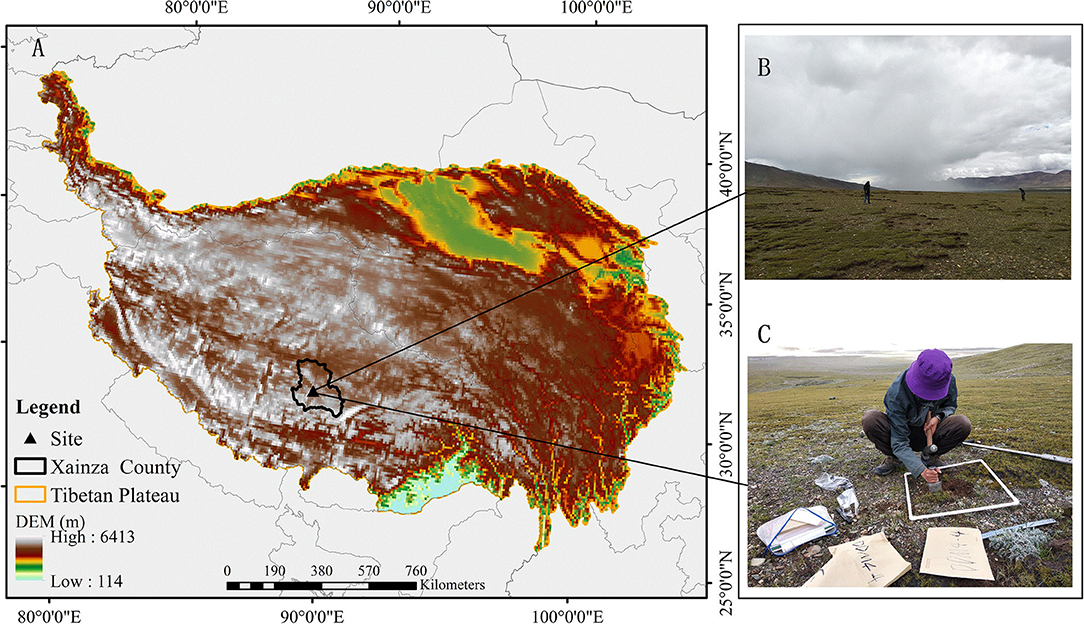
Figure 1. The location of sampled sites in Xainza County on the Tibetan Plateau (A). (B,C) presented the landscape of sampled site and sampled quadrat, respectively.
Data Collection
One typical degraded alpine steppe was chosen as our sample area after wide field surveys in Xainza County. Based on the dividing method by Ma et al. (2002) and Zhang et al. (2019), we divided the degraded grasslands into seven sequent degrees degradation according to vegetation coverage and bare land area. As the seven sites were adjacent, the climatic and topographic conditions were similar. Each site was about 20 m wide and 50 m long where the grasslands were relatively homogeneous with a specific degradation. The transition region between two adjacent sites was excluded when we identified and classified degraded extents, and the conditions of alpine steppes were apparently divergent among different sites. The degraded extents gradually increased from the 1st to the 7th sites of degraded grasslands, and the detailed information were displayed in Table 1. The sampling survey was conducted in July and August 2017 during the peak growing season. In order to collect plant and soil samples as well as measure their characteristics, we randomly selected three pairs of 50 × 50 cm quadrats as pseudo replicates within each site, which is a common sampling method for this type of study (Zhang et al., 2019).
The vegetation community characteristics within each quadrat were identified and recorded, including the plant coverage, species, and number. Aboveground plant parts were clipped at the ground level with scissors, while belowground plant parts were directly excavated. The plant samples were separated by plant species and transported to the lab, where they were oven-dried at 65°C for 72 h in the laboratory to determine the plant biomass. Soil water content (SWC) and compactness (SCOM) were measured with portable Time Domain Refectometry equipment (TDR 100, Spectrum Technologies Inc., Chicago, United States) at the soil depth of 0–30 cm with depth intervals of 0–10, 10–20, and 20–30 cm, three replicate soil samples within each quadrat were obtained via soil cores 5 cm in diameter for other soil property measurements.
The three replicate soil samples were mixed thoroughly, air-dried, and sieved through a 2-mm mesh after the visible roots and other debris were removed. Then, we divided the mixed samples into three parts as replicates to determine soil properties. Soil total carbon (STC) and soil total nitrogen (STN) were determined using a vario MACRO cube elemental analyzer (Elementar Analysensysteme GmbH, Germany) (Bao, 2000). Soil total phosphorus content was determined via the NaHCO3 alkali digestion method and molybdenum antimony colorimetric test (Bao, 2000). Soil available nitrogen was measured using the continuous alkali-hydrolyzed reduction-diffusion method (Bao, 2000). Soil available phosphorus was determined via the Olsen method (Olsen et al., 1954; Bao, 2000). The soil physicochemical properties at 0–30 cm depth were shown in Table 2.
Statistical Analyses
The Margalef Index was used to determine SR which was calculated by the following formula (Margalef, 1957):
where D is the Margalef Index, S and N represent the number of objective species and the total number of plant individuals in the ecosystem.
We used a simple approach proposed by previous studies to explore the trade-off between two objectives (graminoids and forbs) by computing the root mean square error of the individual benefits (Bradford and Damato, 2012; Sun et al., 2018). Based on the root mean square error, the distance from the objective point to the zero trade-off line can be quantified, which can represent the extent of overall benefits for graminoids and forbs. The trade-off was decomposed into one of two dimensions tracing the proportion shift of graminoids and forbs in response to grassland degradation. The benefit for biomass of a single objective plant community defined as the relative deviation from the mean of a given observation is calculated as follows (Bradford and Damato, 2012):
where Bi represents the magnitude of benefit for objective i; xi, xmin, and xmax stand for the observed, minimum, and maximum values for objective i. The individual benefits range from 0 to 1 and can be conceptualized as the proportion of possible benefits in objective i (AGB of graminoids or forbs) realized in response to a given degradation. The root mean square error approximates the distance from the “1:1 line” of the zero trade-off and stands for the extent of overall benefits for AGB of graminoids or forbs.
One-way analysis of variance was performed to determine the differences in soil properties along degradation gradient and the differences in root parameters between graminoids and forbs. The least significant difference was used to determine which ingredients differed at the 0.05 significant level. The redundancy analysis was applied based on the data of soil and plant characteristics to detect their cumulative contribution rates on degradation gradient after separately logarithmical and hellinger standardizing treatment, and the packages of “vegan,” “ggrepel,” and “ggplot2” in software R (R Core Team., 2016) were used for the redundancy analysis. Linear regression analysis was used to reveal the tendency of trade-off value of AGB of forbs along the degradation gradient. Correlation analysis and heatmap were carried out the packages of “corrplot” in software R (R Core Team., 2016) to explore the relationships among trade-off value of AGB of forbs, SR, and soil physicochemical properties. These analyses were performed by using SigmaPlot for Windows version 14.0 (Systat Software, Inc., Chicago, IL, United States), SPSS 19.0 software (SPSS Inc., Chicago, IL, United States), ArcGIS 10.1 (ESRI, Inc., Redlands, CA, United States), and R software (R Core Team., 2016).
Results
Variations in Soil Physicochemical Properties Along the Degradation Gradient
The redundancy analysis results revealed that the first two axes explained 86.91% of the total variance within the relationship between soil properties and plant characteristics at all seven degraded grasslands (Figure 2), of which the eigenvalue of the first and second axis accounted for 68.66% and 18.25% in sequence. For the distribution patterns of soil properties and sites of degraded grasslands, there were stronger relevancies between SCOM with the 7th site, also between STC with the 1st and 3rd sites, while the other sites were more associated with STN, soil available phosphorus, and SWC (Figure 2).
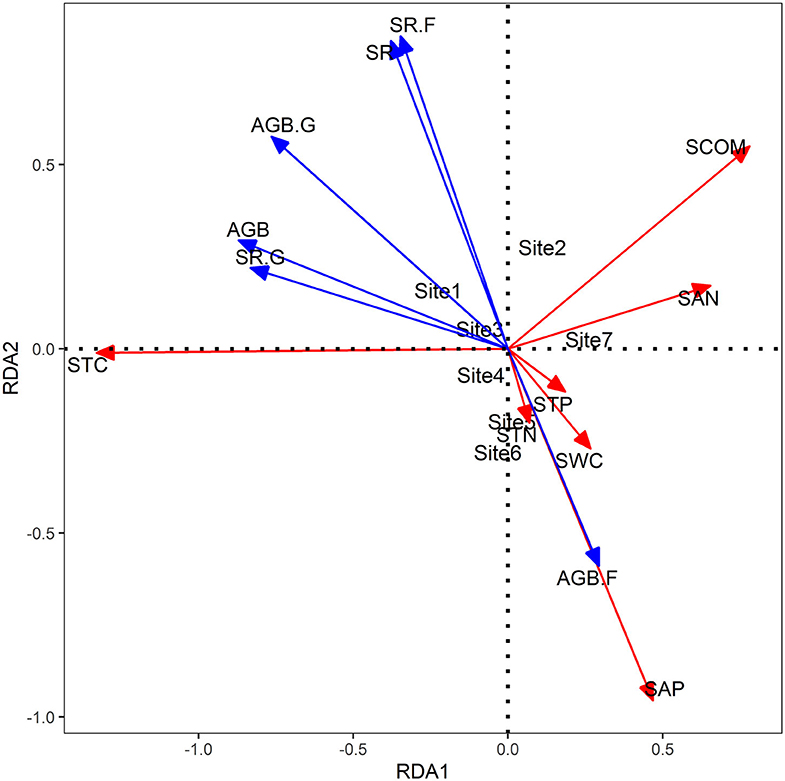
Figure 2. The redundancy analysis of soil variables and vegetation characteristics with different degrees of degradation. The red and blue arrows represent soil variables and vegetation characteristics, respectively. STC, STN, SAN, SAP, STP, SCOM, SWC, AGB, AGB.G, AGB.F, SR, SR.G, SR.F represent soil total carbon, soil total nitrogen, soil available nitrogen, soil available phosphorus, soil total phosphorus, soil compactness, soil water content, overall aboveground biomass, aboveground biomass of graminoids, aboveground biomass of forbs, overall species richness, species richness of graminoids, and species richness of forbs, respectively.
The concentrations of STC, STN, SCOM, and SWC consistently decreased with increasing degraded degress, while there was no significant difference in soil available nitrogen, and slight increases in soil available phosphorus and total phosphorus (Table 2). The variations occurred most distinctly in the surface soil layer (0–10 cm), and gradually weakened with increasing soil depth. Compared to the potential degraded grassland, the topsoil STC, STN, SCOM, and SWC in the most severe degradation were reduced by 76.8, 45.7, 38.4, and 45.6%, respectively. All the soil elements showed a strong depth dependence except for soil total phosphorus. The amounts of STC, STN, and soil available nitrogen were higher in surface layers (0–10 cm) than these in subsurface layers (10–30 cm), while SCOM and SWC gradually increased with increasing soil depth (Table 2).
Variations in Plant Characteristics Along the Degradation Gradient
A comparatively good ranking result was obtained via the redundancy analysis with ranking values of −0.87 for overall AGB, −0.83 for SR of graminoids, −0.76 for AGB of graminoids, −0.38 for overall SR, −0.35 for SR of forbs, and 0.29 for AGB of forbs along the first axis. For the distribution patterns of plant characteristics and sites of degraded grasslands, the 1st, 2nd, and 3rd sites were more correlated to overall AGB and SR, AGB, and SR of graminoids, and SR of forbs. However, the other sites were more relevant to AGB of forbs (Figure 2).
The overall and gramineous AGB distinctly decreased with increasing degradation, while a slight increase in the AGB of forbs was observed (Figure 3). The overall and forb SR exhibited dramatic declines along the degradation gradient, by contrast, the SR of graminoids slightly decreased (Figure 3). As the degradation increased, the trade-off value of AGB of forbs apparently rose turning to positive with R square value of 0.64 (P < 0.05; Figure 4).
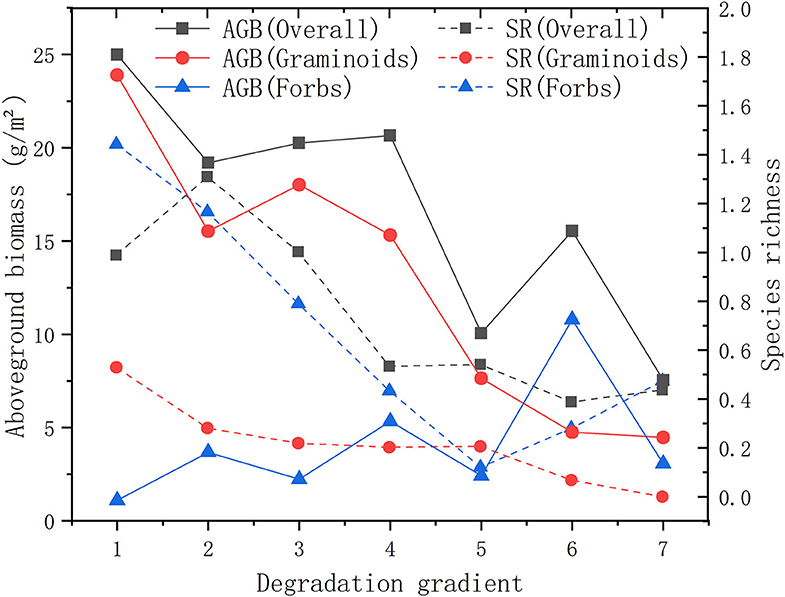
Figure 3. Variations of aboveground biomass (AGB) and species richness (SR) along a degradation gradient. The solid and dashed lines stand for AGB and SR, respectively.
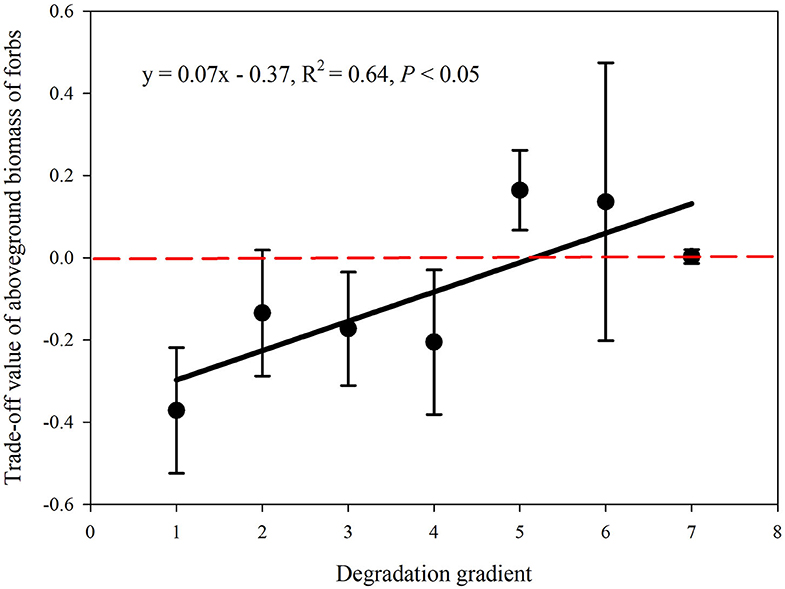
Figure 4. Changes in the trade-off values of aboveground biomass of forbs along a degradation gradient. The red dashed line represents zero value level.
The mean root length of forbs was 16.28 ± 1.18 cm, significantly longer than that of graminoids (13.20 ± 0.78 cm) (P < 0.05, Figure 5A). The root diameter presented no significant difference between graminoids and forbs at the middle and terminal parts, while significantly diverged at the top 1/3 (P < 0.05, Figure 5B). Specially, the mean root diameter of forbs at the top 1/3 part was 2.82 ± 1.2 cm apparently larger than 0.63 ± 0.34 cm of graminoids (P < 0.05, Figure 5B).
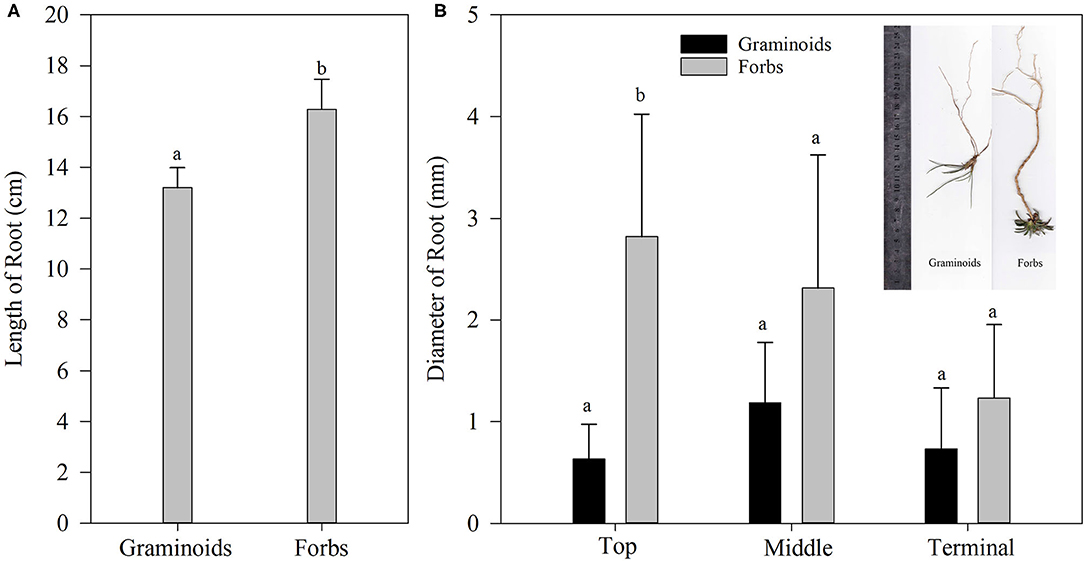
Figure 5. The root morphological traits of graminoids and forbs. (A) Length of root; (B) diameter of root. Top, middle, and terminal represent the top, middle, and terminal parts (one third) of root. Different letters indicate significant difference at 0.05 level. The photo visually displays the differences of root length and thickness between graminoids and forbs.
Relationships of Trade-Off Value of AGB of Forbs With Soil Properties and Species Richness
Figure 6 indicates that the trade-off value of AGB of forbs was significantly correlated with most soil factors at the 95% confidence interval level. Specially, the trade-off value of AGB of forbs presented significantly negative associations with SWC, SCOM, STC, STN, and soil available nitrogen in the 0–30 cm soil layer, while positively correlated to soil total phosphorus with R2 = 0.65, 0.92, 0.84, 0.74, 0.71, and 0.69, respectively (Figure 6). Additionally, there was a negative relationship between the trade-off value of AGB of forbs with SR (R2 = 0.61).
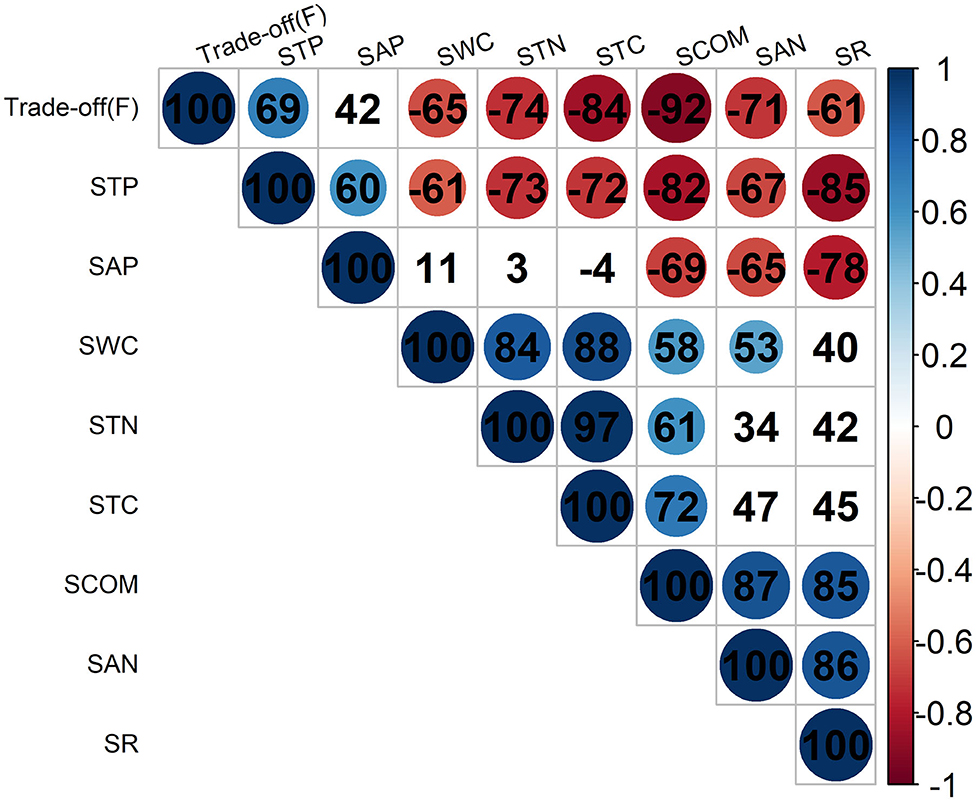
Figure 6. Relationships of trade-off value of aboveground biomass of forbs [Trade-off(F)] with soil properties at 0–30 cm soil depth (STC, STN, SAN, STP, SAP, SCOM, and SWC represent soil total carbon, soil total nitrogen, soil available nitrogen, soil total phosphorus, soil available phosphorus, soil compactness, and soil water content, respectively), and species richness (SR). The highlighted colored solid circles indicate significant correlations between variables at 0.05 level.
Discussion
Variations of Soil Properties Along the Degradation Gradient
Grassland degradation can affect soil physical properties and nutrition ingredients and thereby result in soil degradation (Zhang et al., 2019). In this study, we found a gradual reduction in SCOM with increasing degradation (Table 2), suggesting that degradation contributes to less cohesive soil in alpine steppe. This is consistent with previous studies that degradation leads to decrease in clay but increase in silt content for soil composition, which has a negative impact on SCOM (Yi et al., 2012). Hence, the decline in SCOM may be a powerful indicator of soil degradation in alpine steppe (Feng et al., 2010).
SWC could influence the retention and transfer of available nutrients (Swift et al., 2004). In the present study, we observed a sharp decrease in SWC with enhanced degradation (Table 1), which is another major negative influence of degradation on soils, consistent with previous findings (Wang et al., 2009; Yi et al., 2012). It may be because retrogression induces decreases in field capacity and saturated hydraulic conductivity (Pan et al., 2017), which play important positive roles in key hydraulic courses and functions, such as water holding capacity, soil water retention, and infiltration (Fu et al., 2015). Additionally, due to the decline in plant cover, more soil areas are exposed to stronger radiation, which induces an increase in evaporation-reducing SWC (Wang et al., 2009). Meanwhile, due to enhanced soil evaporation and intensified root uptake, SWC in the surface (0–10 cm) layer is lower than that in the subsurface layer (10–30 cm) (Table 1). This phenomenon is in accordance with other observations (Wang et al., 2009; Pan et al., 2017).
As expected, STC and STN consistently decreased with increasing degradation in our study (Table 1). Similar results were also found by numerous prior studies (Wang et al., 2009; Peng et al., 2018; Zhang et al., 2019). These findings suggested that reduced soil C and N storage are the primary consequence of degradation in alpine steppe, which can cause poor soil quality and further accelerate degradation (Dong et al., 2012; Peng et al., 2018). There are a series of reasons for the decreases in STC and STN with the enhanced degradation: First, the distinct reductions in litter input and root activities with increasing degradation level hinder organic matter accumulation (Wang et al., 2010). Second, degradation leads to decrease in vegetation coverage and thereby accelerates water and soil erosion causing nutrient loss (Zhu et al., 2011; Dlamini et al., 2014). Third, degradation causes an increase in bare land area exposed to radiative heating and thus increases soil temperature, which promotes soil respiration leading to rapid consumption of soil organic matters (Wang et al., 2009). Fourth, changes in plant species composition can cause a range of changes in soil biochemical processes. As previous studies have revealed that litter decomposition and nutrient release relatively slowly occur in forbs than graminoids (Li et al., 2014). Finally, degradation worsen the soil microenvironment and induced the reductions of soil microorganisms and enzyme activities (Cai et al., 2014; Zhou et al., 2018) which desirable for the decomposition of organic matter (Zhao et al., 2014). By contrast, there was a slight increase in soil total phosphorus along the degradation gradient (Table 1). It can be explained as that soil P with lower diffusivity is primarily derived from rock weathering, which is relatively responsive to climate and parent materials in alpine steppe (Chen et al., 2013).
Our results showed that SCOM, SWC, STC, and STN more strongly responded to degradation in the upper layer (0–10 cm), whereas were less sensitive in the deeper layers (10–30 cm) (Table 1). This finding is in agreement with previous studies that the effects of degradation on soil properties are primarily manifested in the top soil (Zeng et al., 2013; Fu et al., 2015; Pan et al., 2017). It is likely due, for the most part, to the degradation-induced declines in plant cover and root grasp. As a result, the topsoil becomes more susceptible to environmental drivers such as wind, raindrops, and surface flow, which directly causes soil erosion, degradation, and even sandification in the alpine steppe (Pan et al., 2017).
Habitat Conditions and Root Morphological Traits Determine Plant Community Shift
Consistent with numerous other reports (Gao et al., 2011; Yang et al., 2013), our results showed that the SR consistently decreased from potentially to severely degraded grassland (Figure 3). This result can be explained by a basic ecological theory that the number of plant species is constrained by nutrient availability (Wang et al., 2014). The composition of plant community has important effect on nutrient cycling at ecosystem levels (Epstein et al., 2001; Olofsson et al., 2001). As SR increases, the capacity of a plant community to utilize natural resources improves (Wang et al., 2016). Previous studies have revealed that SR is highest under moderate, rather than high or low nutrient status (Wang et al., 2010). Because a medium disadvantaged condition appears to balance plant abundance for limited resource utilization (Wang et al., 2009). Therefore, the decrease in SR with increasing degradation is expected to occur in nutrient-deficient sites, where degradation decreases fertility falling below the level with potential SR peak. This suggests that grassland degradation might increase the risk of species extinction on the Tibetan Plateau (Lambers, 2015; Urban, 2015).
Community differences in species composition along gradation levels was evident in the varied components of AGB. We found that the trade-off value of AGB of forbs significantly with enhanced degradation (Figure 4). Similar observations were obtained by other researchers (Wang et al., 2009; Wu et al., 2009) who reported a shift from palatable grasses to weeds along degradation gradient in alpine grasslands, indicating that degradation is a process of reversed vegetation succession with deterioration of plant community structure. Variations of plant functional groups are closely linked to ecological status shifting toward dominance by competitive exclusion (Wang et al., 2010). Forbs are proved to have higher adaptation to the hostile environmental conditions caused by degradation (Wang et al., 2009). The following several mechanisms maybe contribute to the increase in trade-off value of AGB of forbs with increasing degraded extents observed here.
For habitat conditions, plant growth highly depends on soil nutrients in the infertile alpine steppe (Ganjurjav et al., 2016). In particular, graminoids were more susceptible to soil nutrients due to weak leaf interior self-regulation (Geng et al., 2012). For example, graminoids have relatively high nitrogen requirements, so that their biomass is strongly constrained by nitrogen limitation (Wang et al., 2010). By contrast, forbs exhibit more competitive advantages in soils with limited nutrients, reflected by the negative relationships between trade-off value of AGB of forbs with STC, STN, and soil available nitrogen in this study (Figure 6). In addition to the higher requirement of graminoid physiological activities for soil nutrients, it is also because lower nutrients directly hinder the growth of microorganisms and alter their community structure (Breulmann et al., 2012), which is greatly associated with the populations of graminoids (Zhou et al., 2018). Hence, degradation-induced limited soil nutrient availability is a main driver of the increase in forb proportion of the degraded alpine steppe ecosystems (Wang et al., 2010; Wu et al., 2010).
Soil water is another important environmental condition in altering plant colonization and distribution specially in the arid alpine steppe (Sun et al., 2013; Ma et al., 2017). Soil water conditions can affect soil nutrient supply ability and drive plant succession in alpine steppe (Yang et al., 2013; Hou et al., 2018). For example, low SWC is inhospitable to nitrogen uptake for graminoids which is more nitrophilous (Hou et al., 2018). Additionally, even a small variation in SWC may cause a remarkable difference in both seed germination and seedling survival, which consequently affects the individual amount and composition of plant community (Ma et al., 2017). As grassland degradation lead to a dramatic decrease in SWC (Table 2), by which graminoids are largely constrained, while forbs inversely dominate the degraded alpine steppe, indicated by the negative correlation between trade-off value of AGB of forbs with SWC (Figure 6). This result highlights the vital role of SWC in regulating community composition responding to degradation (Fan et al., 2010; Yang et al., 2013).
For root morphological traits, forbs were found to have remarkably longer roots than graminoids (Figure 5). What's more, previous studies have revealed that plant rooting depths varied with different species, which influences the uptake of soil water and the ability to exploit high-nutrient patches (Farley and Fitter, 1999). Specially, forbs root relatively deeper to utilize resources in subsoil when water and nutrients in topsoil sharply decreased, indicated by the slight increase in AGB of forbs with increasing degradation levels (Figure 3). However, graminoids produce crowd-short rhizomatous tissues that are shallowly rooted and extends horizontally in the surface soil (Wang et al., 2009). As a result, degradation, which induced sharp declines of topsoil SWC and nutrients (Table 2), increases the proportion of deep-rooted and drought resistant forbs, whereas conversely decreases the shallow-rooted graminoids in the alpine steppe (Klein et al., 2008).
In the present study, the trade-off value of AGB of forbs was significantly negatively correlated to SCOM (Figure 6), establishing forbs as more plastic in cohesionless soil than graminoids. This result is consistent with previous findings that forbs have greater competitive ability than grasses in severely degraded alpine grassland which leads to less cohesive soil (Gao et al., 2011). It is largely due to that the mean root diameter of forbs is significantly thicker than that of graminoids (Figure 5B). Thicker roots provide a better structure to fix the plant against large gale-force winds, increase water storage capacity under arid conditions, and reduce mechanical damage caused by freeze–thaw cycles (Körner, 1999).
However, thick roots help forbs adapt to the harsh environment (e.g., droughts and freeze–thaw cycles) at the cost of efficiency loss in nutrients acquisition (Körner, 1999). As we know, thick roots serve as an excellent way of storage and carriage in alpine grassland, whereas, fine roots are the primary absorptive roots for nutrients (Hong et al., 2018). Alpine plant species thus face a trade-off between tolerance and nutrient absorption. Forbs have fewer fine roots and are mostly axial root species, while graminoids have higher root densities and higher root areas with clustered roots improving the nutritive acquisition rates (Li et al., 2011). Previous studies have demonstrated that graminoids which respond quickly to nutrient increase tend to dominate the plant community and exclude other species when fertilized (Wang et al., 2010). This can explain the low trade-off of forbs in potentially degraded grassland (Figure 4), suggesting that graminoids have greater competitive ability than forbs in soils with rich water and nutrients which can satisfy plant growth requirements (Gao et al., 2011).
Conclusion
Our results provide strong evidence that grassland degradation results in soil water and nutrient losses, decreasing species richness, and increasing proportion of forbs. The ever-changing habitat condition caused by grassland degradation, together with plant root morphological traits determine the shifting composition of plant community, by which the ecosystem makes full use of limited resources such as water and nutrients to maintain stability and functions. Our findings are of important implications for the conservation and management of alpine grassland ecosystems. The composition of species and their functional traits must be considered to ensure healthy ecosystem function in the process of managing and restoring the degraded grasslands. Intensive management interventions such as weeding may be needed to promote the sustainable development of grasslands in long term. In this study, we only demonstrated the variations of plant community structure along the degradation gradient in alpine steppe from soil and plant morphological traits sides. However, more comprehensive investigation of the potential mechanisms is needed in the future. Hence, plant physiological and genetic methods will be studied in subsequent research.
Data Availability Statement
The datasets generated for this study are available on request to the corresponding author.
Author Contributions
ZZ and JS conceived the study, collected and analyzed the data, drew the graphs, and wrote and revised the manuscript.
Funding
Funding was provided by the State Key Research Development Program of China (Grant No. 2016YFC0502002), the China Postdoctoral Science Foundation (Grant No. 2017M620889), and the Second Tibetan Plateau Scientific Expedition and Research (Grant No. 2019QZKK0405).
Conflict of Interest
The authors declare that the research was conducted in the absence of any commercial or financial relationships that could be construed as a potential conflict of interest.
Acknowledgments
We appreciate the contributions of Ge Hou and Biying Liu in field survey and lab activities.
References
Bradford, J. B., and Damato, A. W. (2012). Recognizing trade-offs in multi-objective land management. Front. Ecol. Environ. 10, 210–216. doi: 10.1890/110031
Breulmann, M., Schulz, E., Weishuhn, K., and Buscot, F. (2012). Impact of the plant community composition on labile soil organic carbon, soil microbial activity and community structure in semi-natural grassland ecosystems of different productivity. Plant Soil 352, 253–265. doi: 10.1007/s11104-011-0993-6
Cai, X. B., Peng, Y. L., Yang, M. N., Zhang, T., and Zhang, Q. (2014). Grassland degradation decrease the diversity of arbuscular mycorrhizal fungi species in tibet Plateau. Not. Bot. Horti. Agrobot. Cluj. Napoca. 42, 333–339. doi: 10.15835/nbha.42.2.9458
Chen, Y. H., Han, W. X., Tang, L. Y., Tang, Z. Y., and Fang, J. Y. (2013). Leaf nitrogen and phosphorus concentrations of woody plants differ in responses to climate, soil and plant growth form. Ecography 36, 178–184. doi: 10.1111/j.1600-0587.2011.06833.x
Cheng, J. M., Wu, G. L., Zhao, L. P., Li, Y., Li, W., and Cheng, J. M. (2018). Cumulative effects of 20-year exclusion of livestock grazing on above- and belowground biomass of typical steppe communities in arid areas of the Loess Plateau, China. Plant Soil Environ. 57, 40–44. doi: 10.17221/153/2010-PSE
Cheng, X. L., An, S. Q., Chen, J., Li, B., Liu, Y. H., and Liu, S. (2007). Spatial relationships among species, above-ground biomass, N, and P in degraded grasslands in Ordos Plateau, northwestern China. J. Arid Environ. 68, 652–667. doi: 10.1016/j.jaridenv.2006.07.006
Dlamini, P., Chivenge, P., Manson, A., and Chaplot, V. (2014). Land degradation impact on soil organic carbon and nitrogen stocks of sub-tropical humid grasslands in South Africa. Geoderma 235, 372–381. doi: 10.1016/j.geoderma.2014.07.016
Dong, S. K., Wen, L., Li, Y., Wang, X. X., Zhu, L., and Li, X. Y. (2012). Soil-quality effects of grassland degradation and restoration on the Qinghai-Tibetan Plateau. Soil Sci. Soc. Am. J. 76, 2256–2264. doi: 10.2136/sssaj2012.0092
Epstein, H. E., Burke, I. C., and Mosier, A. R. (2001). Plant effects on nitrogen retention in shortgrass steppe 2 years after 15N addition. Oecologia 128, 422–430. doi: 10.1007/s004420100670
Fan, J. W., Shao, Q. Q., Liu, J. Y., Wang, J. B., Harris, W. W., Chen, Z. Q., et al. (2010). Assessment of effects of climate change and grazing activity on grassland yield in the three rivers headwaters region of Qinghai–Tibet Plateau, China. Environ. Monit. Assess 170, 571–584. doi: 10.1007/s10661-009-1258-1
Farley, R. A., and Fitter, A. H. (1999). The responses of seven co-occurring woodland herbaceous perennials to localized nutrient-rich patches. J. Ecol. 87, 849–859. doi: 10.1046/j.1365-2745.1999.00396.x
Feng, R. Z., Long, R. J., Shang, Z. H., Ma, Y. S., Dong, S. K., and Wang, Y. L. (2010). Establishment of Elymus natans improves soil quality of a heavily degraded alpine meadow in Qinghai-Tibetan Plateau, China. Plant Soil 327, 403–411. doi: 10.1007/s11104-009-0065-3
Fu, T. G., Chen, H. S., Zhang, W., Nie, Y. P., and Wang, K. L. (2015). Vertical distribution of soil saturated hydraulic conductivity and its influencing factors in a small karst catchment in Southwest China. Environ. Monitor. Assess. 187:92. doi: 10.1007/s10661-015-4320-1
Ganjurjav, H., Gao, Q. Z., Gornish, E. S., Schwartz, M. W., Liang, Y., Cao, X. J., et al. (2016). Differential response of alpine steppe and alpine meadow to climate warming in the central Qinghai-Tibetan Plateau. Agr. Forest Meteorol. 223, 233–240. doi: 10.1016/j.agrformet.2016.03.017
Gao, Y. H., Zeng, X. Y., Schumann, M., and Chen, H. (2011). Effectiveness of exclosures on restoration of degraded alpine meadow in the eastern Tibetan Plateau. Arid Soil Res. Rehabil. 25, 164–175. doi: 10.1080/15324982.2011.554954
Geng, Y., Wang, Z. H., Liang, C. Z., Fang, J. Y., Baumann, F., Kuhn, P., et al. (2012). Effect of geographical range size on plant functional traits and the relationships between plant, soil and climate in Chinese grasslands. Global Ecol. Biogeogr. 21, 416–427. doi: 10.1111/j.1466-8238.2011.00692.x
Guo, Z. G., Li, X. F., Liu, X. Y., and Zhou, X. R. (2012). Response of alpine meadow communities to burrow density changes of plateau pika (Ochotona curzoniae) in the Qinghai-Tibet Plateau. Acta Ecol. Sin. 32, 44–49. doi: 10.1016/j.chnaes.2011.12.002
Harris, R. B. (2010). Rangeland degradation on the Qinghai-Tibetan plateau: a review of the evidence of its magnitude and causes. J. Arid Environ. 74, 1–12. doi: 10.1016/j.jaridenv.2009.06.014
He, J. S., Wang, X. P., Flynn, D. F. B., Wang, L., Schmid, B. H., and Fang, J. Y. (2009). Taxonomic, phylogenetic, and environmental trade-offs between leaf productivity and persistence. Ecology 90, 2779–2791. doi: 10.1890/08-1126.1
Hong, J. T., Ma, X. X., Yan, Y., Zhang, X. K., and Wang, X. D. (2018). Which root traits determine nitrogen uptake by alpine plant species on the Tibetan Plateau. Plant Soil 424, 63–72. doi: 10.1007/s11104-017-3434-3
Hou, G., Sun, J., and Wang, J. N. (2018). Dynamics and controls of carbon use efficiency across China's grasslands. Pol. J. Environ. Stud. 27, 1541–1550. doi: 10.15244/pjoes/76912
Jing, Z. B., Cheng, J. M., Su, J. S., Bai, Y., and Jin, J. W. (2014). Changes in plant community composition and soil properties under 3-decade grazing exclusion in semiarid grassland. Ecol. Eng. 64, 171–178. doi: 10.1016/j.ecoleng.2013.12.023
Klein, J. A., Harte, J., and Zhao, X. Q. (2008). Decline in medicinal and forage species with warming is mediated by plant traits on the Tibetan Plateau. Ecosystems 11, 775–789. doi: 10.1007/s10021-008-9160-1
Körner, C. (1999). Alpine Plant Life: Functional Plant Ecology of High Mountain Ecosystems. (Heidelberg: Springer Verlag Berlin).
Lambers, J. H. R. (2015). Extinction risks from climate change. Science 348, 501–502. doi: 10.1126/science.aab2057
Li, A., Niu, K. C., and Du, G. Z. (2011). Resource availability, species composition and sown density effects on productivity of experimental plant communities. Plant Soil 344, 177–186. doi: 10.1007/s11104-011-0738-6
Li, Y. Y., Dong, S. K., Wen, L., Wang, X. X., and Wu, Y. (2014). Soil carbon and nitrogen pools and their relationship to plant and soil dynamics of degraded and artificially restored grasslands of the Qinghai–Tibetan Plateau. Geoderma 213, 178–184. doi: 10.1016/j.geoderma.2013.08.022
Liu, Y. J., Mao, L., Li, J. Y., Shi, G. X., Jiang, S. J., Ma, X. J., et al. (2015). Resource availability differentially drives community assemblages of plants and their root-associated arbuscular mycorrhizal fungi. Plant Soil 386, 341–355. doi: 10.1007/s11104-014-2261-z
Liu, Y. W., Xuri, Xu, X., Wei, D., Wang, Y. H., and Wang, Y. S. (2013). Plant and soil responses of an alpine steppe on the Tibetan Plateau to multi-level nitrogen addition. Plant Soil 373, 515–529. doi: 10.1007/s11104-013-1814-x
Ma, M. J., Dalling, J. W., Ma, Z., and Zhou, X. H. (2017). Soil environmental factors drive seed density across vegetation types on the Tibetan Plateau. Plant Soil 419, 349–361. doi: 10.1007/s11104-017-3348-0
Ma, Y. S., Lang, B. N., Li, Q. Y., Shi, J. J., and Dong, Q. M. (2002). Study on rehabilitating and rebuilding technologies for degenerated alpine meadow in the Changjiang and Yellow river source region. Pratacult. Sci. 19, 1–5. doi: 10.3969/j.issn.1001-0629.2002.09.001
Margalef, R. (1957). Information theory in ecology. Mem. R Acad. Cienc. Artes Barc. 32, 373–449. doi: 10.1017/S0031819100052062
Niu, K. C., Zhang, S. T., Zhao, B. B., and Du, G. Z. (2010). Linking grazing response of species abundance to functional traits in the Tibetan alpine meadow. Plant Soil 330, 215–223. doi: 10.1007/s11104-009-0194-8
Olofsson, J., Kitti, H., Rautiainen, P., Stark, S., and Oksanen, L. (2001). Effects of summer grazing by reindeer on composition of vegetation, productivity and nitrogen cycling. Ecography 24, 13–24. doi: 10.1034/j.1600-0587.2001.240103.x
Olsen, S. R., Cole, C. V., Watanabe, F. S., and Dean, L. A. (1954). Estimation of available phosphorus in soils by extraction with sodium carbonate. USDA Circ. 939, 1–19.
Pan, T., Hou, S., Wu, S. H., Liu, Y. J., Liu, Y. H., Zou, X. T., et al. (2017). Variation of soil hydraulic properties with alpine grassland degradation in the Eastern Tibetan Plateau. Hydrol Earth Syst. Sc. 21, 2249–2261. doi: 10.5194/hess-21-2249-2017
Peng, F., Xue, X., You, Q., Huang, C., Dong, S., Liao, J., et al. (2018). Changes of soil properties regulate the soil organic carbon loss with grassland degradation on the Qinghai-Tibet Plateau. Ecol. Indic. 93, 572–580. doi: 10.1016/j.ecolind.2018.05.047
Piao, S. L., Tan, K., Nan, H. J., Ciais, P., Fang, J. Y., Wang, T., et al. (2012). Impacts of climate and CO2 changes on the vegetation growth and carbon balance of Qinghai-Tibetan grasslands over the past five decades. Glob. Planet Change 98, 73–80. doi: 10.1016/j.gloplacha.2012.08.009
R Core Team. (2016). R: A Language and Environment for Statistical Computing. Vienna, Austria: R Foundation for Statistical Computing. Available online at: https://www.rproject.org/ (accessed December 12, 2016).
Sun, J., Cheng, G. W., and Li, W. P. (2013). Meta-analysis of relationships between environmental factors and aboveground biomass in the alpine grassland on the Tibetan Plateau. Biogeosciences 10, 1707–1715. doi: 10.5194/bg-10-1707-2013
Sun, J., Ma, B., and Lu, X. (2018). Grazing enhances soil nutrient effects: Trade-offs between aboveground and belowground biomass in alpine grasslands of the Tibetan Plateau. Land Degrad. Dev. 29, 337–348. doi: 10.1002/ldr.2822
Sun, J., and Wang, H. M. (2016). Soil nitrogen and carbon determine the trade-off of the above- and below-ground biomass across alpine grasslands, Tibetan Plateau. Ecol. Indic 60, 1070–1076. doi: 10.1016/j.ecolind.2015.08.038
Sun, J., Wang, X. D., Cheng, G. W., Wu, J. B., Hong, J. T., and Niu, S. L. (2014). Effects of grazing regimes on plant traits and soil nutrients in an Alpine Steppe, Northern Tibetan Plateau. PLoS ONE 9:e108821. doi: 10.1371/journal.pone.0108821
Sun, J., Zhang, Z. C., and Dong, S. K. (2019). Adaptive management of alpine grassland ecosystems over Tibetan Plateau. Pratacult. Sci. 36, 933–938.
Swift, M. J., Izac, A., and van Noordwijk, M. (2004). Biodiversity and ecosystem services in agricultural landscapes—are we asking the right questions? Agrie Ecosyst. Environ. 104, 113–134. doi: 10.1016/j.agee.2004.01.013
Urban, M. C. (2015). Accelerating extinction risk from climate change. Science 348, 571–573. doi: 10.1126/science.aaa4984
Wang, C. T., Long, R. J., Wang, Q. J., Jing, Z. C., and Shi, J. J. (2009). Changes in plant diversity, biomass and soil C, in alpine meadows at different degradation stages in the headwater region of three rivers, China. Land Degrad. Dev. 20, 187–198. doi: 10.1002/ldr.879
Wang, C. T., Long, R. J., Wang, Q. L., Liu, W., Jing, Z. C., and Zhang, L. (2010). Fertilization and litter effects on the functional group biomass, species diversity of plants, microbial biomass, and enzyme activity of two alpine meadow communities. Plant Soil 331, 377–389. doi: 10.1007/s11104-009-0259-8
Wang, H. M., Sun, J., Li, W. P., Wu, J. B., Chen, Y. J., and Liu, W. H. (2016). Effects of soil nutrients and climate factors on belowground biomass in an alpine meadow in the source region of the Yangtze-Yellow rivers, Tibetan Plateau of China. J. Arid Land 8, 881–889. doi: 10.1007/s40333-016-0055-2
Wang, P., James, P., Lassoie, S., Morreale, J., and Dong, S. K. (2015). A critical review of socioeconomic and natural factors in ecological degradation on the Qinghai-Tibetan Plateau, China. Rangeland J. 37, 1–9. doi: 10.1071/RJ14094
Wang, Q., Yu, C., Pang, X. P., Jin, S. H., Zhang, J., and Guo, Z. G. (2018). The disturbance and disturbance intensity of small and semi-fossorial herbivores alter the belowground bud density of graminoids in alpine meadows. Ecol. Eng. 113, 35–42. doi: 10.1016/j.ecoleng.2018.01.003
Wang, X. X., Dong, S. K., Yang, B., and Li, Y. Y. (2014). The effects of grassland degradation on plant diversity, primary productivity, and soil fertility in the alpine region of Asia's headwaters. Envir. Mon. Ass. 186, 6903–6917. doi: 10.1007/s10661-014-3898-z
Wang, Y. F., Yu, S. X., and Wang, J. (2007). Biomass-dependent susceptibility to drought in experimental grassland communities. Ecol. Lett. 10, 401–410. doi: 10.1111/j.1461-0248.2007.01031.x
Wu, G. L., Du, G. Z., Liu, Z. H., and Thirgood, S. (2009). Effect of fencing and grazing on a Kobresia-dominated meadow in the Qinghai-Tibetan Plateau. Plant Soil 319, 115–126. doi: 10.1007/s11104-008-9854-3
Wu, G. L., Liu, Z. H., Zhang, L., Hu, T. M., and Chen, J. M. (2010). Effects of artificial grassland establishment on soil nutrients and carbon properties in a black-soil-type degraded grassland. Plant Soil 333, 469–479. doi: 10.1007/s11104-010-0363-9
Yang, Z. L., Guo, H., Zhang, J. Y., and Du, G. Z. (2013). Stochastic and deterministic processes together determine alpine meadow plant community composition on the Tibetan Plateau. Oecologia 171, 495–504. doi: 10.1007/s00442-012-2433-6
Yi, X. X., Li, G. S., and Yin, Y. Y. (2012). The impacts of grassland vegetation degradation on soil hydrological and ecological effects in the source region of the yellow river–a case study in junmuchang region of Maqin country. Proced. Environ. Sci. 13, 967–981. doi: 10.1016/j.proenv.2012.01.090
Zeng, C., Zhang, F., Wang, Q., Chen, Y., and Joswiak, D. R. (2013). Impact of alpine meadow degradation on soil hydraulic properties over the Qinghai-Tibetan Plateau. J. Hydrol. 478, 148–156. doi: 10.1016/j.jhydrol.2012.11.058
Zhang, Z. C., Hou, G., Liu, M., Wei, T. X., and Sun, J. (2019). Degradation induces changes in the soil C:N:P stoichiometry of alpine steppe on the Tibetan Plateau. J. Mt. Sci-Engl. 16, 2348–2360. doi: 10.1007/s11629-018-5346-y
Zhao, C. Z., Zhu, L. Y., Liang, J., Yin, H. J., Yin, C. Y., Li, D. D., et al. (2014). Effects of experimental warming and nitrogen fertilization on soil microbial communities and processes of two subalpine coniferous species in Eastern Tibetan Plateau, China. Plant Soil 382, 189–201. doi: 10.1007/s11104-014-2153-2
Zhou, H., Zhang, D. G., Jiang, Z. H., Sun, P., and Xiao, H. L. (2018). Changes in the soil microbial communities of alpine steppe at Qinghai-Tibetan Plateau under different degradation levels. Sci. Total Environ. 651, 2281–2291. doi: 10.1016/j.scitotenv.2018.09.336
Zhou, W., Gang, C. C., Zhou, L., Chen, Y. Z., Li, J. L., Ju, W. M., et al. (2014). Dynamic of grassland vegetation degradation and its quantitative assessment in the northwest China. Acta Oecol. 55, 86–96. doi: 10.1016/j.actao.2013.12.006
Keywords: forbs, species richness, plant community structure, root morphological trait, degradation, alpine steppe, Tibetan Plateau
Citation: Zhang Z and Sun J (2020) Root Features Determine the Increasing Proportion of Forbs in Response to Degradation in Alpine Steppe, Tibetan Plateau. Front. Environ. Sci. 8:534774. doi: 10.3389/fenvs.2020.534774
Received: 14 February 2020; Accepted: 25 September 2020;
Published: 26 October 2020.
Edited by:
Xian Xue, Northwest Institute of Eco-Environment and Resources (CAS), ChinaReviewed by:
Shikui Dong, Beijing Normal University, ChinaJessica M. Furrer, Benedict College, United States
Copyright © 2020 Zhang and Sun. This is an open-access article distributed under the terms of the Creative Commons Attribution License (CC BY). The use, distribution or reproduction in other forums is permitted, provided the original author(s) and the copyright owner(s) are credited and that the original publication in this journal is cited, in accordance with accepted academic practice. No use, distribution or reproduction is permitted which does not comply with these terms.
*Correspondence: Jian Sun, c3VuamlhbkBpZ3NucnIuYWMuY24=
 Zhenchao Zhang
Zhenchao Zhang Jian Sun
Jian Sun